The Rivian R1T Is the Sports-Car Driver's Off-Roader
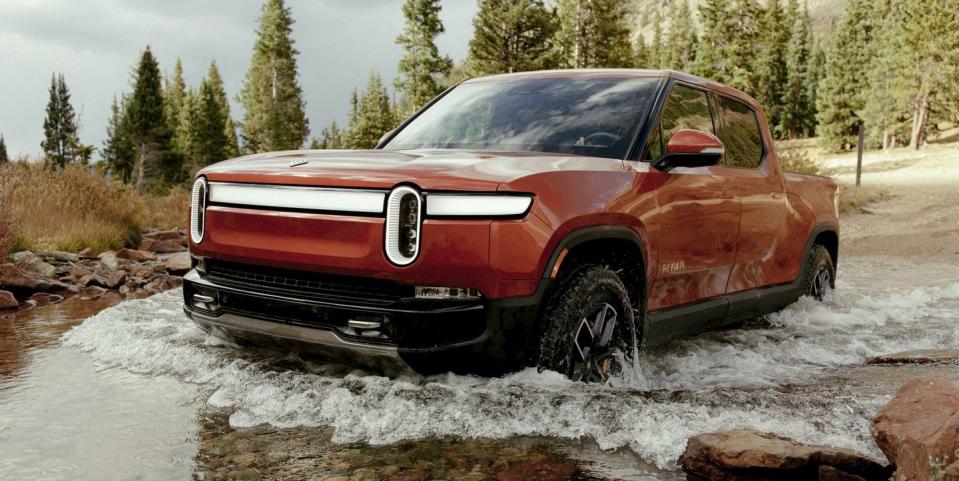
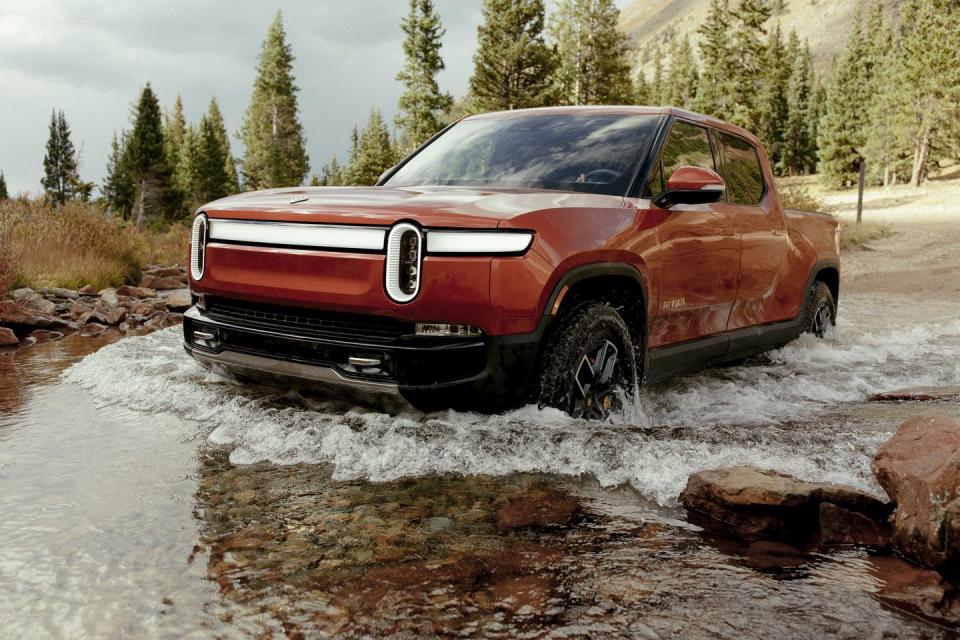
Don’t think of Rivian as a truck company. Sure, the brand’s first production vehicle, the R1T you see here, is a four-door pickup truck. And next to launch will be the R1S, a three-row SUV based on the R1T. And then there’s the cartoonish RPV, an electric delivery van with up to 900 cubic feet of cargo space. Amazon hopes to have 100,000 of these rigs in service by 2030.
Trucks, all of them. But when founder RJ Scaringe launched his company—in 2009, in his twenties, having just finished engineering school—his dream was to build a mid-engine hybrid sports car. And if you want to understand Rivian, you have to think of it as a sports-car company.
This story originally appeared in Volume 8 of Road & Track.
SIGN UP FOR THE TRACK CLUB BY R&T FOR MORE EXCLUSIVE STORIES
The evidence sits snug on the centerline of the R1T’s chassis: four electric motors, one driving each wheel. The Rivian is the first mass-produced four-motor EV—even Tesla’s top-tier Model S Plaid has just one motor for the front axle. With each wheel driven independently, the Rivian can do legit torque vectoring, with all the instant adjustability and response that make electric motors so tantalizing. It’s what you’d build if your drivetrain department were run by club racers and rally hoons.
It’s also a great way to put immense power to the ground. Right now Rivian offers one drivetrain setup: 415 hp and 413 lb-ft of torque at the front axle, plus 420 hp and 495 lb-ft at the rear. Factor in the reduction gearing inside each motor (a roughly 12:1 ratio), and that comes out to well over 10,000 lb-ft of torque at the tires, good for a claimed 3.0-second 0–60 time and a governed top speed of 110 mph. The 135-kWh battery provides an EPA-estimated 314 miles of range, and Rivian says the rig can tow up to 11,000 pounds.
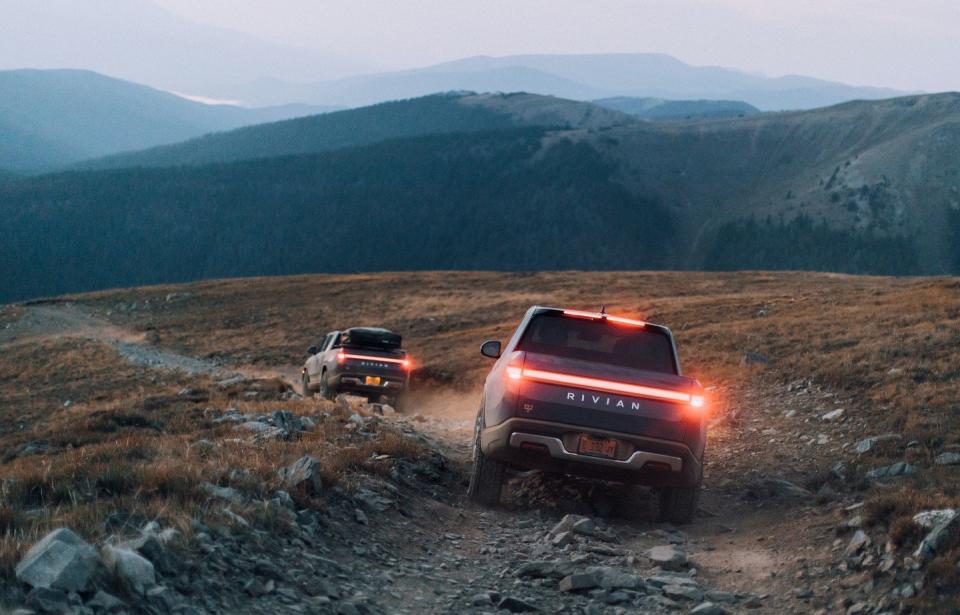
At Rivian’s launch event in Breckenridge, Colorado, those numbers were easily believable. The R1T weighs 6950 pounds but accelerates ferociously, with no wheelspin, even on 34-inch Pirelli all-terrain tires. The truck rides on height-adjustable air suspension; even its lowest ride height still offers nearly 10 inches of ground clearance.
And it corners dead flat. The R1T tackles sweeping mountain back roads like a sport sedan. The battery weight is all underneath your feet and between the axles for an enviably low center of gravity. But the real magic is in the adaptive dampers. They’re hydraulically linked across the axles: When you go around a left-hand curve, the passenger-side dampers compress, forcing fluid into the bottom of the driver-side dampers, compressing the suspension on the inside wheels to counteract body roll. This eliminates the need for conventional anti-roll bars. Roll stiffness is controlled via the valves and accumulators that link the dampers, adjusted on the fly based on the driving mode you choose. It’s similar to what’s in McLaren’s most advanced supercars. Coincidentally, Rivian employs a few McLaren veterans.
So there’s no anti-roll bar to disconnect when you’re headed for the trail. You simply engage off-road mode—which raises the rig to nearly 15 inches of ground clearance—and go. Rivian’s demonstration route had us spending most of the day on a steep, technical trail that took us above the tree line past 12,000 feet of elevation, a narrow path we traversed at mostly single-digit speeds.
The R1T has four-wheel independent suspension with upper and lower control arms. The inboard motor placement keeps driveshaft angles to a minimum. The motors themselves are barricaded behind the truck’s perfectly flat belly, the full length of it clad in bashproof panels. Hard-learned habits suddenly become irrelevant: You don’t have to worry about smacking your front differential or snagging a crossmember on a rock or a stump.

The shortcomings of internal combustion are most apparent when you’re rock-crawling. A gas-burning engine needs a brace of gear ratios to stay in its ideal rpm range—plus locking differentials (or complex, laggy electronics to simulate a locker) to maximize traction. Any off-road excursion is a constantly changing math problem, picking the right gear to get the right rpm to carry the right amount of speed to trundle through without spinning tires or bogging down.
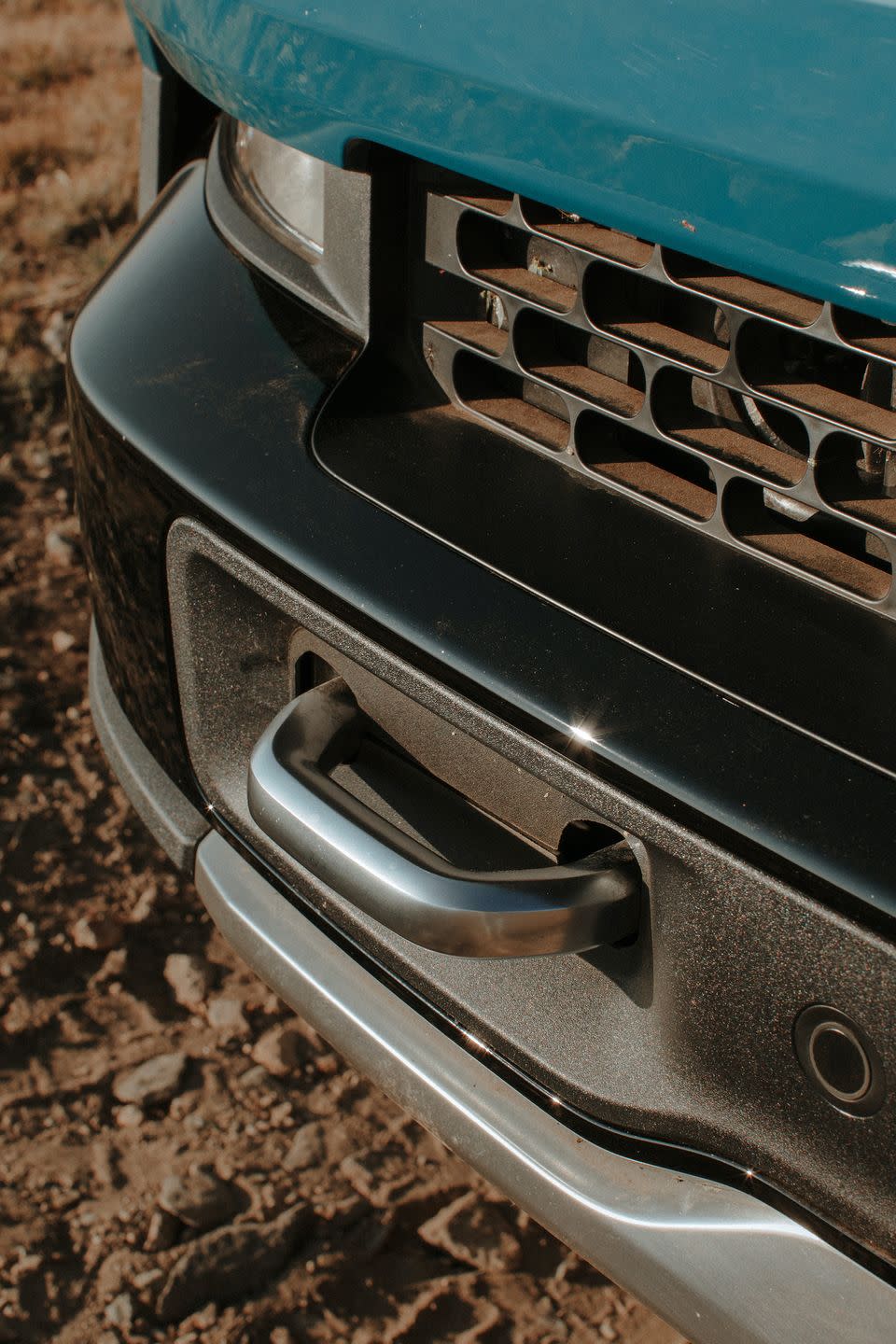
The R1T asks you to do precisely none of that. You never wonder whether to downshift for power or stay in a higher gear for gentler throttle response. You never need a running start to conquer a steep climb. You can thread a hairpin turn without fighting locked-diff axle hop. The instant torque and split-second reactiveness mean you’ll never get caught uselessly spinning a wheel that’s dangling in the air. The calibration is spot-on; off-road mode gives you gentle response from a long accelerator pedal, perfect for minute adjustments as you power over obstacles. Through frame-twisting transitions, over loose rocks, and up steep, white-knuckle climbs, nudging the R1T along was blissfully easy. And silent: The only sounds during our climbs and descents were the crunch of rock under tire and ambient tones of undisturbed nature.
It’s hard to overstate how revolutionary this feels. This is what off-roading should have always been—it’s just that, until now, we’ve had to compensate for internal combustion’s shortfalls on every trail ride.
Rivian isn’t the only automaker pursuing off-road-capable EVs. The R1T will soon be joined by electric four-by-fours from a bunch of legacy automakers, and more start-ups are sure to follow.
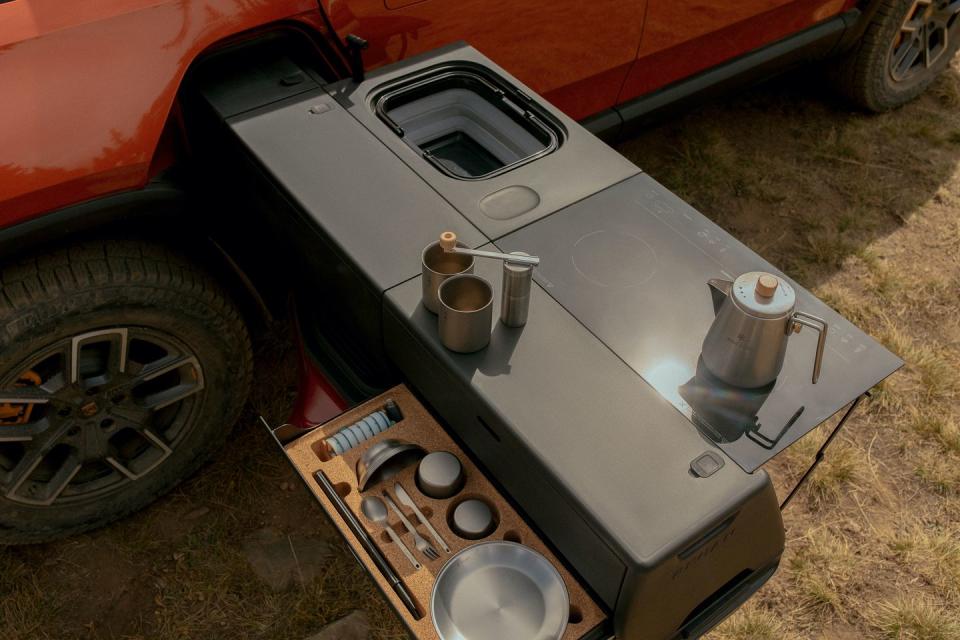
But while many upcoming EV off-roaders bring a cargo hold full of macho corniness (hello, new Hummer), the R1T is packed with stuff a true outdoor adventurer would love—like a bed-mounted air compressor (good for 150 psi), a cable-lock system (for keeping your mountain bike or kayak or whatever safe), and, yes, the Camp Kitchen.

Witness the Gear Tunnel, a full-width storage chamber nestled below the back seats and in front of the rear wheel wells, accessible from either side. It’s big enough to contain one six-foot automotive journalist but is better suited to stashing duffel bags or dirty outdoor gear. For $5000, you can spec your R1T with the Camp Kitchen, which slides out of the Gear Tunnel complete with a two-burner induction cooktop, a four-gallon water tank with pump, a pop-out sink, a four-person tableware set, and a full coffee-making setup. The whole thing draws power from the Rivian’s main battery; running both burners full blast for an hour should eat up only a mile or two of driving range, according to the company. Is it a party trick? Sure it is. During our two days in Colorado, Rivian’s team prepared every meal for more than a dozen people on one truck’s cooktop.
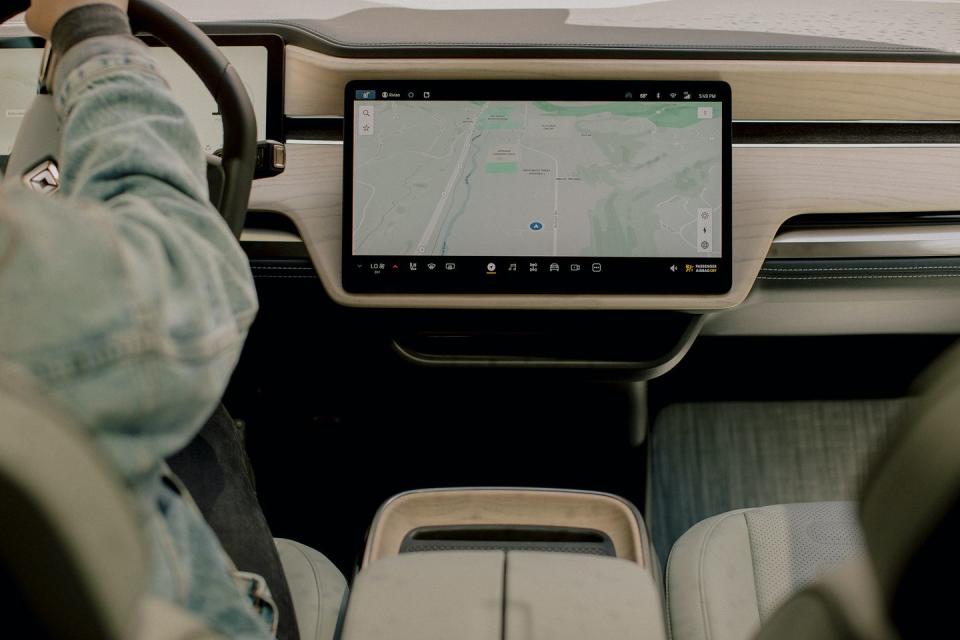
The R1T isn’t perfect. The interior is stylish but too sparse, a victim of touchscreen temptation. Adjustments for sideview mirrors, steering-wheel tilting and telescoping, and A/C vent direction all hide deep within submenus. Aside from the window switches and steering-column stalks, there isn’t a single button or knob on the dash. That lends the R1T a glass-encased futurist aesthetic but leaves you fumbling for the simplest tasks. The same tech reliance extends to the exterior: Every enclosure, from the front trunk to the door handles to the Gear Tunnel, tailgate, and tonneau, is electronically operated. In a hardcore off-roader, this seems like an invitation for malfunction. Then again, the whole truck is powered by electrons.
Overall, though, the R1T is a knockout. It’s more capable and competent than it ever needed to be, on the road or off. It’s a triumph of thoughtful engineering, designed by people who wanted a vehicle for both their hobbies and needs. Just like the best sports cars.
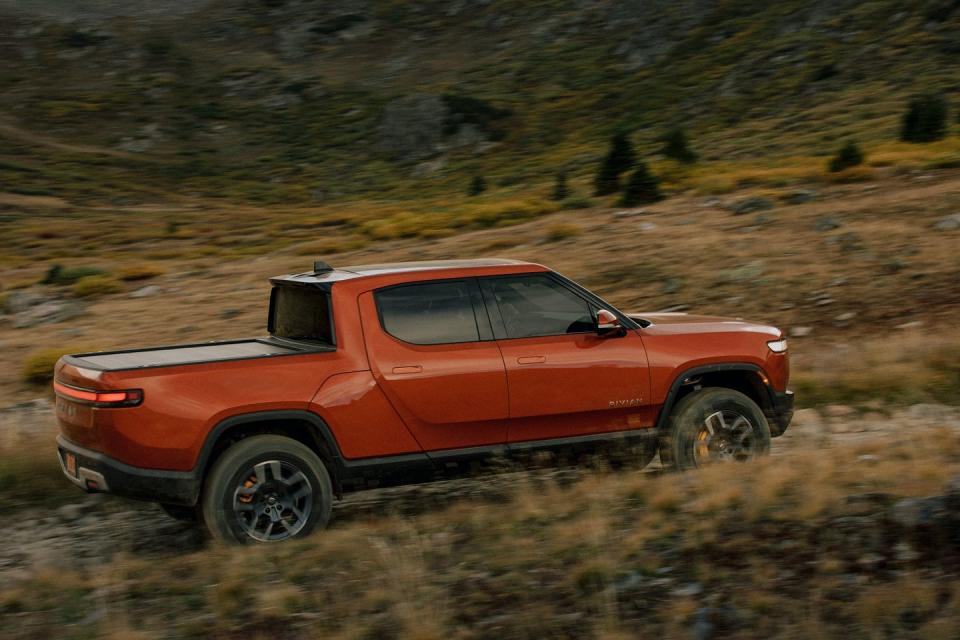
Specifications
2022 Rivian R1T
Price:
$67,500 (base)
Motors:
4 electric motors
Output:
835 hp
908 lb-ft
Transmission:
direct drive
Curb Weight:
6950 lb
0-60 mph:
3.0 seconds
You Might Also Like

 Yahoo Autos
Yahoo Autos 